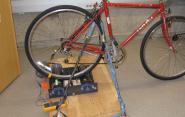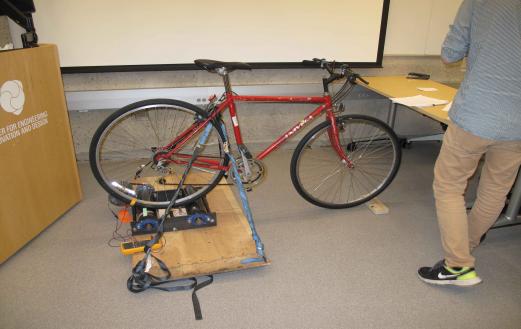As Midterm Approaches, Mechanical Engineering Majors Offer a Glimpse Into Their Capstone Inventions

This week marks the midway point for the fall semester at Yale, and for students enrolled in the wildly popular courses offered by the Center for Engineering Innovation & Design (CEID), that means it’s time to formally present a prototype device for feedback from instructors and classmates. The student teams in CEID courses will then use that feedback to further refine their inventions over the second half of the semester as they prepare for their final public presentations.
One class presenting prototypes this week is “Mechanical Design: Process & Implementation,” a course that serves as the capstone for mechanical engineering majors. Taught by SEAS Deputy Dean Vince Wilczynski, the course focuses on the intricacies of the design process, including concept generation and project management for creatively addressing a real-world design problem.

This week marks the midway point for the fall semester at Yale, and for students enrolled in the wildly popular courses offered by the Center for Engineering Innovation & Design (CEID), that means it’s time to formally present a prototype device for feedback from instructors and classmates. The student teams in CEID courses will then use that feedback to further refine their inventions over the second half of the semester as they prepare for their final public presentations.
One class presenting prototypes this week is “Mechanical Design: Process & Implementation,” a course that serves as the capstone for mechanical engineering majors. Taught by SEAS Deputy Dean Vince Wilczynski, the course focuses on the intricacies of the design process, including concept generation and project management for creatively addressing a real-world design problem.
This year the course consists of three teams of students. The first team to present is developing a portable device for generating electricity when there is no access to a power grid of any kind. Key to this device is a flexibility that can adapt to take advantage of a variety of usable conditions but without a bulky product that might make transportation difficult. As a result, the team is developing a device that generates electricity by harnessing a circular motion that can be powered by water flow, wind gusts, and when nothing else is available, a hand crank.
The second group to present is also solving an energy problem, though in this case it’s a problem inspired by a common dilemma faced by third-world communities: do you pay for electricity to your village or a vehicle to travel beyond the village’s locality? The team’s device could eliminate this dilemma by harnessing the spinning power of a tire on a motorcycle or car with a roller system that fits under the spinning tire. The team hopes this robust system might be used in such a way that a motorcycle could power the entire village.
Finally, the third team is addressing a very different kind of “transportation” problem—an athlete’s knee, particularly the anterior cruciate ligament, or ACL for short. Tearing the ACL is an all-too-common injury for college athletes, often resulting from landing or planting incorrectly in a pivoting sport such as basketball. Working with Karen Sutton, an assistant professor of orthopaedics and rehabilitation at Yale School of Medicine, the students are developing a low-cost, accessible device for predicting and preventing ACL injuries in college athletes. The wearable device measures the angles of the knee as the wearer jumps off a box and onto the ground; the angles of the knee during this test are direct indicators of potential ACL injury later on.
All three teams presented working prototypes that put them well on their way toward innovative devices by the end of the semester. In response, Deputy Dean Wilczynski summed up the significance of the event. “Design is an emotional roller coaster. This is the second highest peak for this class,” he said. “And as I look ahead, I’m really excited for what you all are doing.”

